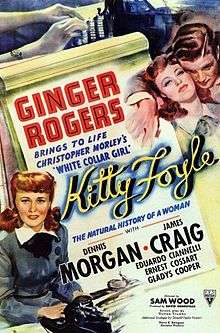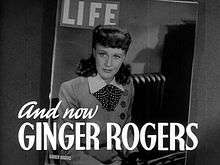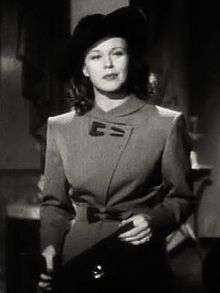Kitty Foyle (film)
| Kitty Foyle | |
|---|---|
 The original 1940 cinema poster | |
| Directed by | Sam Wood |
| Produced by |
David Hempstead Harry E. Edington |
| Screenplay by |
Dalton Trumbo Donald Ogden Stewart |
| Based on |
Kitty Foyle by Christopher Morley |
| Starring |
Ginger Rogers Dennis Morgan James Craig |
| Music by | Roy Webb |
| Cinematography | Robert De Grasse |
| Edited by | Henry Berman |
| Distributed by | RKO Radio Pictures |
Release dates |
|
Running time | 108 minutes |
| Country | United States |
| Language | English |
| Budget | $738,000[1] |
| Box office | $2,385,000[1] |
Kitty Foyle, subtitled The Natural History of a Woman, is a 1940 film starring Ginger Rogers, Dennis Morgan, and James Craig, which is based on Christopher Morley's 1939 bestseller also titled Kitty Foyle. Ginger Rogers won the Academy Award for Best Actress for her portrayal of Kitty Foyle, and the dress she wore in the film became a new dress style, known as a Kitty Foyle dress.
Plot

Kitty Foyle (Ginger Rogers), a saleswoman in a New York boutique working for Delphine Detaille (Odette Myrtil), faces a life-changing decision: marry doctor Mark Eisen (James Craig) or run away to South America with the man she has loved for many years, the already-married Wyn Strafford (Dennis Morgan). As she wrestles with her decision, the film flashes back to her youth in Philadelphia.
As a teenager, Kitty gawks at the city's elite "Main Liners" in a parade that precedes their annual Assembly Ball. Her father (Ernest Cossart) warns against getting carried away with her fantasies. Ironically, Kitty meets the embodiment of her dreams in an acquaintance of his: Wynnewood Strafford VI. Wyn offers her a secretarial job at his fledgling magazine. The two fall deeply in love, but when the magazine folds, he does not have the will to defy his social class's strictures by proposing to a woman so far below him socially.
With the death of her father and no prospect of marriage with Wyn, Kitty goes to work in New York for Delphine. One day, she presses the burglar alarm button by mistake at Delphine's fashion store. She pretends to faint to cover her blunder and is attended to by Mark. Mark, aware she is faking it, playfully blackmails her into a first date.
Wyn finally breaks down and finds Kitty in New York. The two wed, but agree that the only way their marriage can work is if they do not live in Philadelphia. When he introduces her to his family, she gets a chilly reception. She also learns that Wyn would be disinherited and left penniless if he does not remain in Philadelphia and work in the family banking business. She realizes, though Wyn is willing to try, he is not strong enough to deal with poverty. She walks out and they are divorced.
Kitty returns to New York, where she learns that she is pregnant. When Wyn arranges to meet her, her hopes for a reconciliation are raised, only to be dashed when she sees a newspaper announcement of Wyn's engagement to someone of his own social standing. She leaves without seeing him and receives a further blow when the baby dies at birth.
Several years later, Kitty reluctantly agrees to open a Philadelphia branch store for her friend Delphine. By chance, she waits on Wyn's wife and meets their son. She takes the opportunity to entrust the secret return of a family heirloom ring to the boy.
The film returns to the beginning. She decides to marry Mark.
Cast
- Ginger Rogers as Kitty Foyle
- Dennis Morgan as Wynnewood 'Wyn' Strafford VI
- James Craig as Dr. Mark Eisen
- Eduardo Ciannelli as Giono (as Edward Ciannelli)
- Ernest Cossart as Pop
- Gladys Cooper as Mrs. Strafford
- Odette Myrtil as Delphine Detaille
- Mary Treen as Pat
- K. T. Stevens as Molly (as Katharine Stevens)
- Walter Kingsford as Mr. Kennett
- Cecil Cunningham as Grandmother
- Nella Walker as Aunt Jessica
- Edward Fielding as Uncle Edgar
- Kay Linaker as Wyn's Wife
- Richard Nichols as Wyn's Boy
Production
Katharine Hepburn, who starred opposite Rogers (but was frequently at odds with her) in Stage Door, was offered the title role, but turned it down.
The film was adapted by Dalton Trumbo and Donald Ogden Stewart from the 1939 novel Kitty Foyle by Christopher Morley. It was directed by Sam Wood.
Reception
Kitty Foyle was RKO's top film for 1940,[2]:144 earning a profit of $869,000.[2]:155

Reviews from critics were generally positive. Bosley Crowther of The New York Times expressed disappointment that the story had been softened from the novel due to Production Code restrictions, but wrote of the protagonist that "Ginger Rogers plays her with as much forthright and appealing integrity as one can possibly expect."[3] Variety magazine wrote, "Despite its episodic, and at times, vaguely defined motivation, picture on whole is a poignant and dramatic portraiture of a typical Cinderella girl's love story. Several good comedy sequences interline the footage, deftly written and directed. Ginger Rogers provides strong dramatic portrayal in the title role."[4] Film Daily called it "one of the most human pictures that has been produced in Hollywood in many, many moons ... a triumph for Ginger Rogers."[5] Harrison's Reports wrote, "Very good! ... The story is simple but realistic; it has deep human appeal, a stirring romance, and delightful comedy bits; moreover, the performances are excellent." [6]
"I am inclined to think that it's Miss Ginger alone who makes 'Kitty Foyle' a better-than-average film and Kitty herself a proper model for those hundreds of thousands of young things who will now be adding a touch of white to their neckline," John Mosher wrote prophetically in The New Yorker. "Without Miss Ginger, it would be very easy to remember how often many of the scenes shown in this film have been seen before on the screen."[7]
Kitty Foyle was nominated for the Academy Award for Best Picture, Academy Award for Best Actress in a Leading Role, and the Academy Award for Writing Adapted Screenplay. Ginger Rogers won for Best Actress. It was also nominated for Best Director (Sam Wood), Best Sound (John Aalberg).[8]
In 1951, in a series of articles examining film adaptation, Lester Asheim notes that some films "reproduce the costume, housing, and appearance of the novel's prototypes without softening or heightening," but that Kitty Foyle shows the more typical "glamorizing" process of film adaptation:
Kitty Foyle is typical, in every aspect of the adaptation, of the daydream character of film characterization. The glamorizing process carries through from the casting of Ginger Rogers and the Hollywood wardrobe provided her, to such added incidents as Wyn renting an entire nightclub for a night.... While the film retains a scene or two of Kitty's crowded apartment shared with two other girls, such scenes are played for comedy and no attempt is made to convey the day-to-day monotony and routine of the working girl.[9]
Rogers' dress became a popular style, taking the name of the film.[10][11]
The film had a national re-release in 1955.
Adaptations
Kitty Foyle was adapted as a radio play on the May 5, 1941, episode of Lux Radio Theatre with Ginger Rogers reprising her role. Rogers also starred in the April 6, 1946, adaptation heard on Academy Award Theater. On March 3, 1947, it was produced for The Screen Guild Theater starring Olivia de Havilland.
Kitty Foyle was also a TV soap opera starring Kathleen Murray as Kitty Foyle.
References
- 1 2 Richard Jewell, 'RKO Film Grosses: 1931-1951', Historical Journal of Film Radio and Television, Vol 14 No 1, 1994 p55
- 1 2 Jewell, Richard B.; Harbin, Vernon (1982). The RKO Story. New York: Arlington House. ISBN 9780517546567.
- ↑ Crowther, Bosley (January 9, 1941). "Movie Review - Kitty Foyle". The New York Times. Retrieved December 2, 2015.
- ↑ "Kitty Foyle". Variety. New York: Variety, Inc. December 18, 1940. p. 16.
- ↑ "Reviews of the New Films". Film Daily. New York: Wid's Films and Film Folk, Inc.: 6 December 23, 1940.
- ↑ "'Kitty Foyle' with Ginger Rogers, Dennis Morgan and James Craig". Harrison's Reports: 3. January 4, 1941.
- ↑ Mosher, John (January 11, 1941). "The Current Cinema". The New Yorker. New York: F-R Publishing Corp. p. 61.
- ↑ "The 13th Academy Awards (1941) Nominees and Winners". oscars.org. Retrieved 2011-08-13.
- ↑ Asheim, Lester (Summer 1951). "From Book to Film: Mass Appeals". Hollywood Quarterly. 5 (4): 341. ISSN 1549-0076. OCLC 56138080.
- ↑ "Ginger Rogers' passion for fashion". Retrieved 2012-02-07.
- ↑ "IMDB Kitty Foyle trivia". Retrieved 2012-02-07.
External links
| Wikimedia Commons has media related to Kitty Foyle (film). |
- Kitty Foyle at the Internet Movie Database
- Kitty Foyle at the TCM Movie Database
- Kitty Foyle at AllMovie
Streaming audio
- Kitty Foyle on Lux Radio Theater: May 5, 1941
- Kitty Foyle on Academy Award Theater: April 6, 1946
- Kitty Foyle on Screen Guild Theater: March 3, 1947